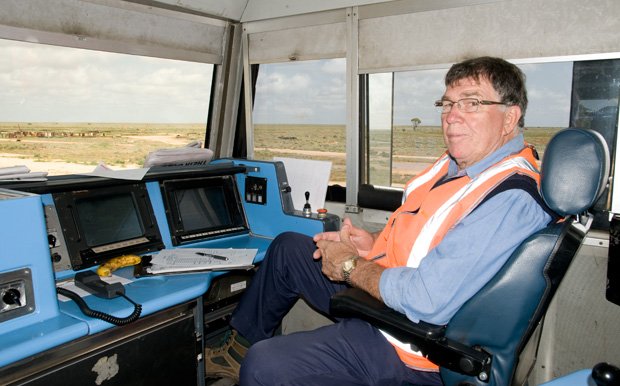On the Indian Pacific: driving the distance

Online editor Carolyn Barry reports back as she travels across the nation on the Indian Pacific – read more in this series.
AFTER A COUPLE OF days on the Indian Pacific, you start to get used to the swaying, rocking floor beneath you, such that when you do hop off during a short break, you tend to keep on swaying. That’s why you notice when the train stops every now and again.
Reasons for the breaks include whistlestops, and courtesy stops for freight trains needing to pass our much slower passenger train. But other mandatory train stops are for changing drivers.
This happens every eight hours or so, when the drivers’ shifts end. This morning at Cook – now a ghost town in the Nullarbor (population: 4) – Shelton Sanft and Peter Manser climbed aboard. Both previously worked in the mines before snagging the job of train driver on “the IP” as they call it.
“I spent years underground in Kalgoorlie and got sick of it,” Peter says. He applied for the train driver job in 1976 and has been one ever since. “It’s been a great career,” he says. “You get to say that you drive one of the great trains of the world – the ‘IP’ – across the Nullarbor. There’s a prestige to that. It’s great.”
The pair are based in Kalgoorlie, where we’re headed next after this stop – in about 8 hours time, once we cross the Nullarbor.

The Indian Pacific, stopped at Cook
For most of the time, there are two drivers (who are usually paired together): one to manage the train and the other to act as the ‘observer’ to look out for obstructions on the track ahead. They switch roles every so often, usually for different segments of the track, or when they need a break from driving.
For safety reasons, a kill switch is installed in the control room such that if a driver fails to press the red “dead man” button in time (every 90 seconds with two drivers, or about every 45 s for a lone driver) the train will stop. It sounds like a scene right out of the television show, LOST, where a countdown and warning siren sounds as the time is almost up. It all seems quite dramatic, but it’s good to know that there are a lot of safety processes in place. Shelton says he’s become so accustomed to pushing the button that sometime when his mobile phone alarm goes off, his hand automatically reached out to whack it.
It’s not often that the train collides with unfortunate wildlife. But it does happen. In Peter’s 36 years at the helm, he’s hit all manner of creatures, including camels, cattle and kangaroos. Most animals hear the train coming and make themselves scarce. But others aren’t so quick – mostly the kangaroos. Shelton once hit 26 kangaroos on a single trip. But camels are the more serious concern. “With the recent rains, they’ve come down from the north and can get quite close to the track,” Peter says. While they’re not big enough to derail the train, they can cause quite bit of damage to “the loco” and even more if they get caught under the train.
On thing’s for sure, these drivers love their jobs. “Look at this,” Peter says, pointing out the front window to the great expanse – and an apparently endless straight track ahead. “How could you not love it? It’s unique out here; it’s just open space; and, you’re your own boss.”

A driver’s view looking out to the longest straight stretch of train tracks in the world.
Indian Pacific – more blogs in this series.
Indian Pacific celebrates 40 years
Gallery: Indian Pacific

